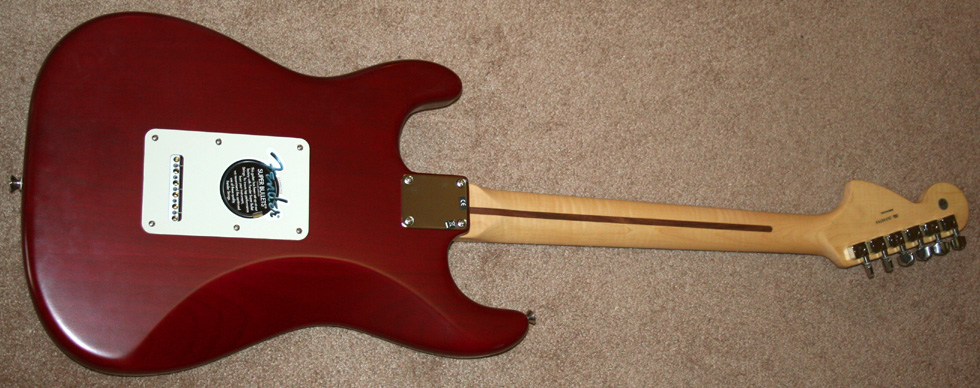
Traditionally, guitars had taken their shape, from the need to make a guitar body an acoustic sound box. Arch tops and arched backs make for a tension at the surface, permitting reverberation. The rounded figure eight shape, makes for no directly reflecting flat surfaces. Amplification changes this. An amplified guitar does not need a body to act as an amplifier. In some cases this can even be a disadvantage. The guitar body can pick up the amplified sound from the amplifier, and feed it back into the pick ups, producing the high pitched feedback hated by all musicians - well by most of them at any rate.
When compared to the Les Paul, the Fender is lighter, thinner, cheaper, and gives better access to the frets. It also balances a bit differently, though this is a matter of taste. The Fender has an odd way of attaching the strings. Where most guitars have a bridge, and then a stop at the back of the guitar, the Fender strings go through the body and attach at the underside of the guitar.
The tail itself was somewhat flexible, and was called a soft tail. It could be easily flexed to change the pitch of the strings. This can be done unaided; but many of these guitars were equipped with a whammy bar, which would allow pitch changes by pushing on a bar screwed into the tail. On a Gibson, and most other guitar makes, doing this requires a spring loaded device called Bigsby, which replaced the tail stock or stop bar. Some guitar players (myself included) do not like the soft tail, because it can be easy to inadvertently strike it, lay your hand on it, or brush across it, thus changing the pitch when nor meaning to do so. Many players would wedge things under the tail, so that it would maintain a fixed position. Eventually, Fender introduced hard tail models, which would not flex. They also introduced a five position switch, which would select between different combinations of the guitar's three pick ups, in order to give different intonation. The body was striking, with its asymmetrical horns, body hugging contours, and curved edges. The body itself is made of alder, with a maple neck.
This is the Highway One model, which is American made. It features vintage seventies styling, which means a big headstock, and wide neck. These guitars
The Highway One is the least expensive American made Stratocaster. It is by no means a cheap of shoddy guitar; but has been simplified in some ways. Mainly, the finish is simpler and less expensive to apply, and some of the electronics are different. A more expensive Stratocaster will have higher end pickups, and more refined electronics, along with a fancier paint job; but the basic construction will not be any better. The Highway One electronics feature something that Fender calls it's Greasbucket system, which is said to be able to moderate screeching highs, without adding more base. Higher end Stratocasters will have more refined electronics; but in these days of modelers and modeling amps, I don't know that this is such a big deal.
